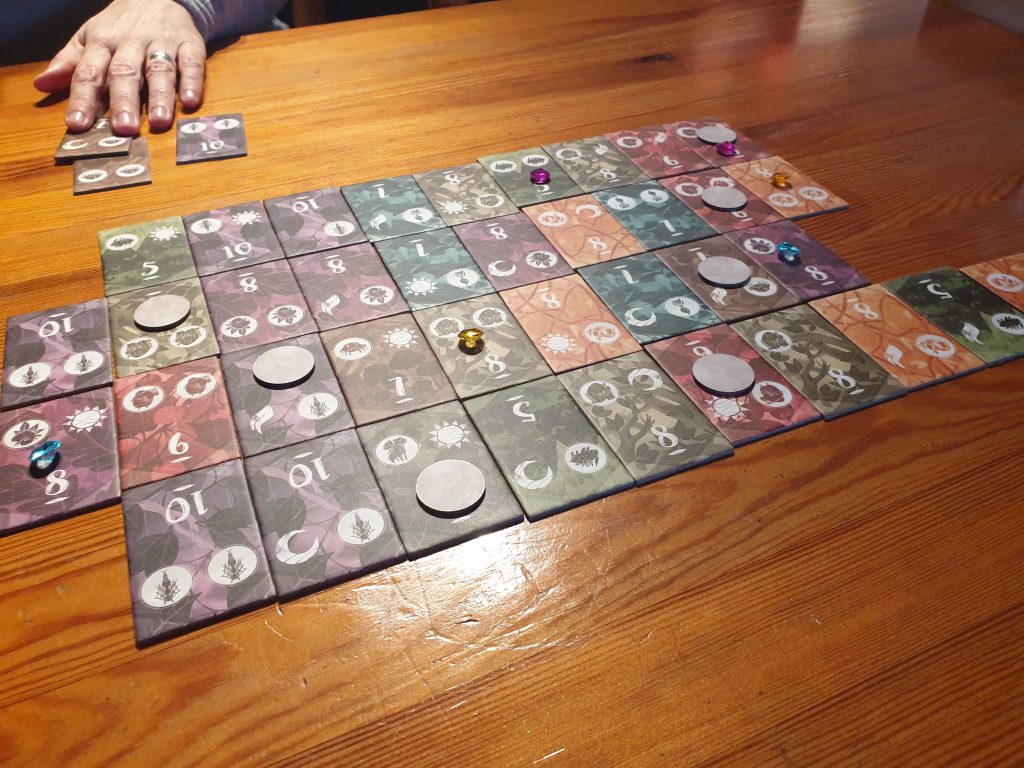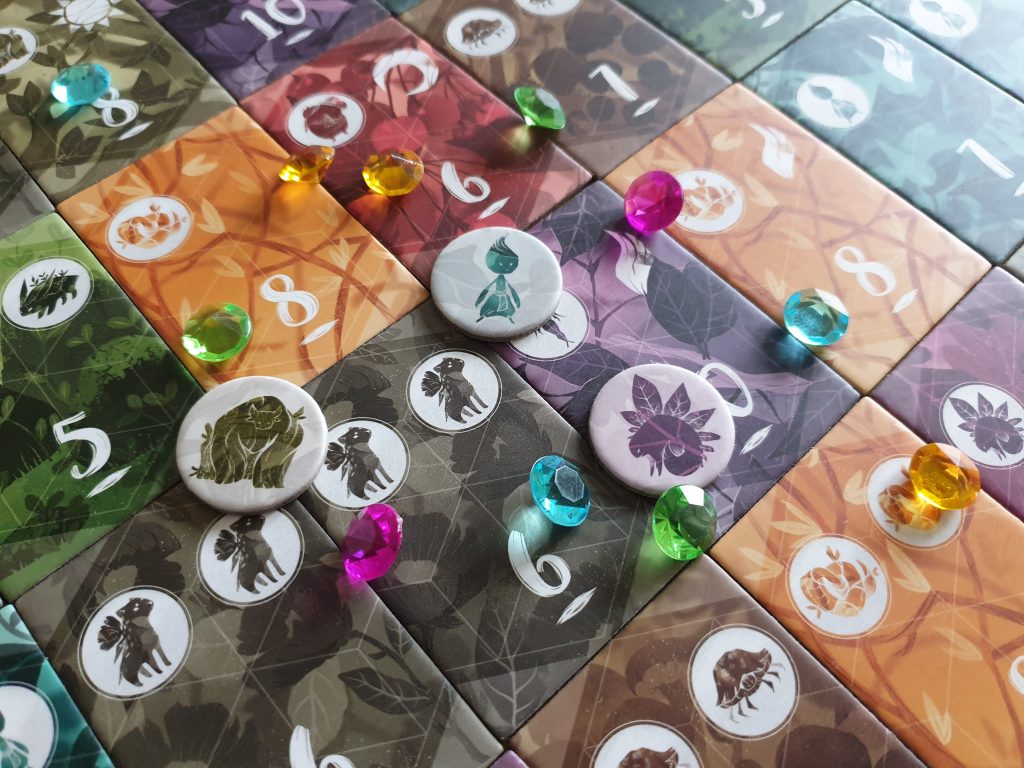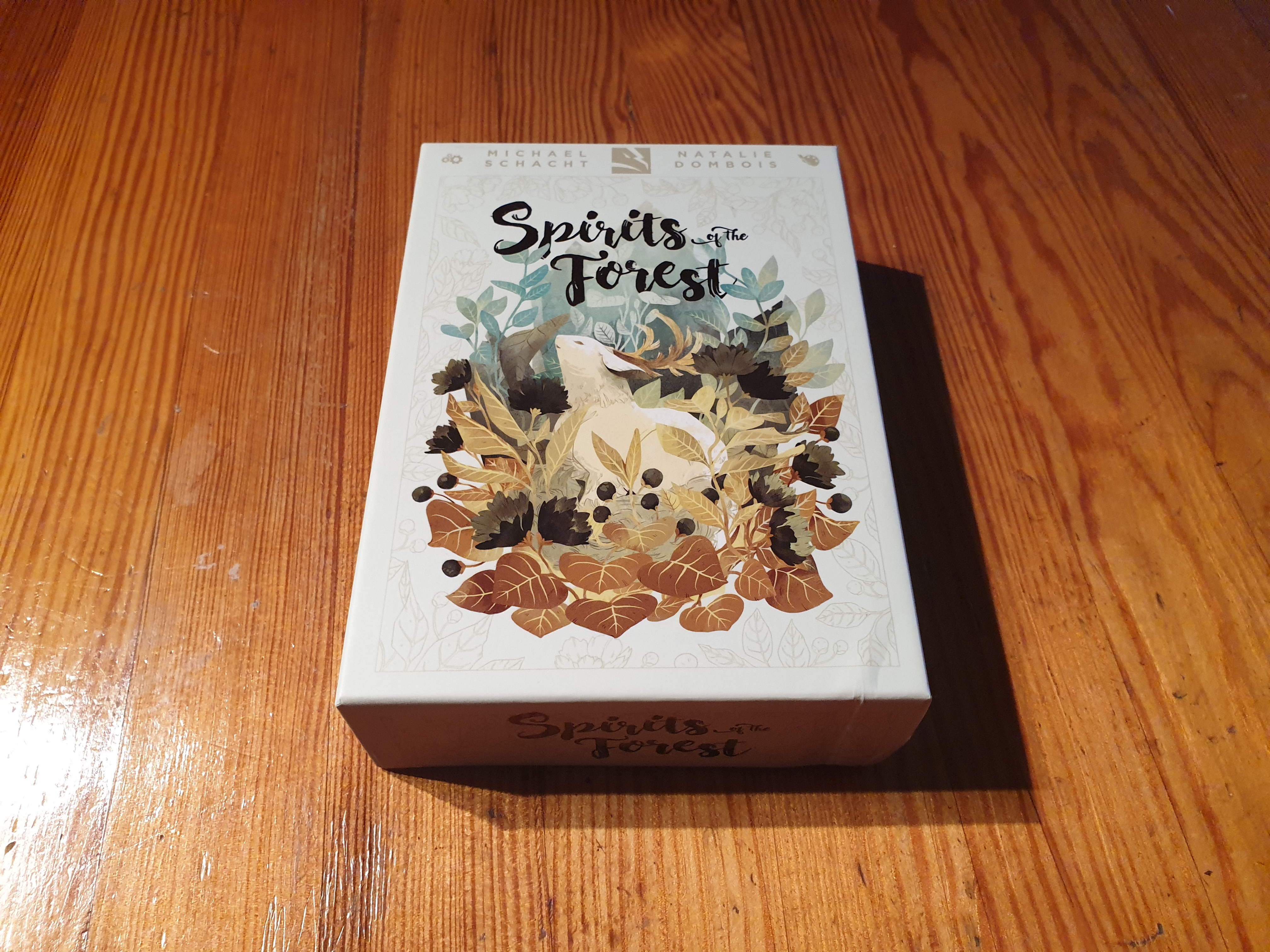Spirits of the Forest is a tile based, set collection board game, which was released in 2018 by publisher ThunderGryph Games. Designed by Michael Schacht, featuring art from Natalie Dombois, the game is designed for 1 – 4 players. In around 20 minutes players will attempt to acquire spirit symbols from a dwindling forest. However, are the forces of nature something gamers will want to experience? Let’s find out!
For a small box game the setup can take a little while if you want to be neat. This is because 48 tiles need to be shuffled and then placed out in 4 joined rows of 12 tiles. This isn’t too long with a couple of people helping but if you have even the slightest OCD about the tiles being aligned it still takes a good minute or two. Once the forest of tiles is laid out, bonus tokens are shuffled with 8 added to the “board”. Finally, players put the end game scoreboard within reach and take three matching colour gemstones.
Turns have two stages, taking a tile/tiles followed by placing a gemstone. The active player can take from either end of the forest, but not the top or bottom – giving a choice of 8 tiles. The player either takes two matching single spirit tiles from the edge or a single double spirit tile. If a gemstone of an opponent is on the tile it is returned to the owner but the active player must discard one of their own gemstones. If unable to discard one of their gemstones, from their hand or from tiles still in the forest, the reserved tile cannot be taken. After this the player can place or move one of their gemstones to any tile left in the forest.

Play then continues clockwise with the next player. Tiles that are gained are placed in front of the player, building up a collection throughout the game. If a tile with a bonus token is claimed the player can look at which symbol is featured, but keeps it secret from the other players. It will either match one of the spirit or power symbols for end game scoring or be a +1 gemstone that can be instantly utilized – though the maximum gemstones a player can have is three.
The game goes until all tiles are taken and the forest is empty. Players now, if they haven’t during the game, arrange their tiles into sets of spirits. Going through the 9 spirits and 3 power sources individually, players determine who has the most symbols, not tiles, of the different types. Whomever has the most of each set scores points equal to the number of symbols they have, including bonus symbols. A player with no symbols of a type, excluding bonus tokens, loses 3 points. Points are counted using a couple of gemstone from each player and the score tracker. As normal, the player with the most points wins.
Spirits of the Forest is one of those games that manages to pack a lot of thinking into only a few components. Whilst there are only 48 tiles in the box they form a decent sized play area, which slowly reduces over the course of the game. There has been some analysis paralysis (AP) moments when playing, from players prone to thinking through every option.
This can slow the game down somewhat, though as the game progresses your previous choices make future choices easier – as players aim to get sets. There are 12 sets to collect though, which means it can take a few games to grasp the importance of each set – as they are of different sizes. The first game can certainly feel like players are randomly trying to grab a bit of everything.

Despite the AP problem, individual turns are generally not too long as the action is either take two matching single spirit tiles or a double spirit tile. This, alongside the set collection mechanics, makes the title extremely easy to teach. So, the phrase “easy to learn, hard to master” strongly applies to Spirits of the Forest. A player with some experience will normally win against a new player. Thankfully, the difference ebbs away quickly as a player gets only a game or two under their belt.
The tiles are slightly dark in colour, with the brightest being a medium red or orange, and some of these colours can blur together – even when adjacent. At the opposite end of the colour palette are the translucent, almost neon coloured, player gemstones. At first this contrast seemed too brash but it tremendously boosts the readability of the game. Dull coloured tokens could have easily blended in with the tiles, with the used colours making pieces pop at a mere glance. It is a shame that this readability isn’t instilled throughout the tiles too.
In a two player game players feel like they have more control over the outcome than in a four player game. With 4 a number of tiles can be made available and taken before you get another turn. This is somewhat limited by the gemstone rules, which nicely balance blocking with allowing tiles to still be taken. On top of this, the choices are always fresh in a 4 player game, as more tiles are taken between turns – with the board rarely on the stale side. Games with 3 players feels like a great middle ground, and I’d probably want to stick to a 2 – 3 player count.
Spirits of the Forest strikes the balance of not having too many choices but meaningful decisions. Just before the choices become predetermined the game ends, so throughout players will need to pay attention. It can be hard on a new player to go into their first game with experienced players, as they will undoubtedly lose. An experienced player simple knows how end game scoring is impacted by their choices. Nevertheless, this isn’t due to them not understanding the game and hasn’t stopped players after a loss instantly wanting a rematch. Therefore, this is another small box game that deserves its space on my gaming shelf!
[Editor’s Note: Spirits of the Forest was provided to us by Asmodee for review purposes. The game is currently available on 365 Games for £18.99. It is also available from local UK board game stores, find your local store here.]

